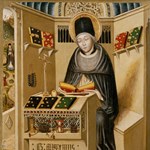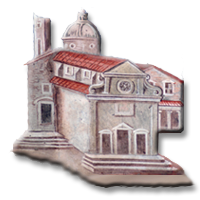Introduzione
The painter of this panel from L'Astor, showing Saint Augustine reading in his study, is unknown. In the background of the panel, through an open doorway, we see the saint walking on the seashore. The scene refers to one of the visions the holy bishop of Hippo had while he was trying to comprehend the mystery of the Trinity. The Infant Jesus appeared to him, seen crouching down trying to empty the sea of water into a hole made in the sand. When Saint Augustine told him he would never do it, the Infant replied that he would achieve it before the saint had understood the mystery of the essence of God. In the foreground we see the saint sitting, reading the book of the scriptures, open on top of the wooden scriptorium where we can see the hourglass, the symbol of the passage of time and the finite nature of earthly things. This iconography of Saint Augustine working in his 'studiolo', just like that of Saint Jerome, is a symbol of the vanity that was widely disseminated in Late Antiquity and was later resumed in the Italian art of the 'trecento' and very especially during the 'quattrocento', coinciding with the reappraisal of the study of the classical authors encouraged by the new humanist culture of the Renaissance. Despite the Gothic feel present in the scene, this is a work from the second half of the 15th century that has already incorporated the meticulous stylistic language of Flemish tradition typical of Jaume Huguet.
fonte: museuepiscopalvic.com



